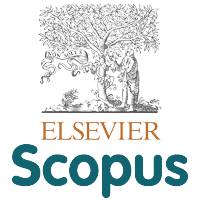STUDY ON FRUIT QUALITY OF SELECTED SEEDED PUMMELO CULTIVARS AND ITS RELATIONSHIP WITH ANTIOXIDANT ACTIVITY CONTENT DURING STORAGE PERIOD
Abstract
Indonesia has number of accessions and cultivars of pummelo which are prospective to be developed. Pummelo contains higher antioxidants thus beneficial for health. This research aimed to get information of physical and chemical quality differences, antioxidant capacity, and explain the relationship between fruit quality and antioxidant capacity of selected seeded pummelo cultivars. Fruit was harvested in Banyuwangi and Magetan while fruit quality assesment was conducted in Laboratory of Agronomy and Horticulture Depart-ment, IPB. The results showed that physical qualities of fruit (weight loss, peel softness and peel color) and chemical qualities (total soluble solids and total titratable acidity) were changed during storage. Adas Nambangan and Banyu-wangi cultivars have better physical and chemi-cal qualities than other cultivars during storage until 10 weeks after harvest because of good visual appearance, the lowest decreased in weight loss and the good ratio of TSS:TTA. Seeded pummelo cultivars with dark red to reddish white fruit pulp had significant higher total phenolic, carotenoid, anthocyanin and anti-oxidant capacity than white fruit pulp. There were negative correlations between antioxidant capacity with colored pulp and total phenolic content. Banyuwangi had the highest antioxidant capacity in the pulp, followed by Bali Merah, Adas Nambangan, Pamelo Magetan, Srinyonya, Bali Putih cultivars.
Keywords
Full Text:
PDFReferences
AOAC. 1995. Official Methods of Analysis of AOAC International, 16th edition. Association of Official Analitical Chemist. Washington, USA. pp. 1141.
BPS. 2015. Pummelo production. Production of Annual Fruit and Vegetable Plants. Statistics Indonesia. http://www.bps.go.id/ webbeta/frontend/site/pilihdata. Accessed on February 10, 2015.
Brand-Williams, W., M.E. Cuvelier and C. Berset. 1995. Use of a free radical method to evaluate antioxidant activity. LWT - Food Science and Technology 28 (1): 25-30. crossref
Chang, C.C., M.H. Yang, H.M. Wen and J.C. Chern. 2002. Estimation of total flavonoid content in propolis by two complementary colorimetric methods. Journal of Food and Drug Analysis 10 (3): 178-182.
Dillard, C.J. and J.B. German. 2000. Phyto-chemicals: nutraceuticals and human health. Journal of the Science of Food and Agriculture 80 (12): 1744-1756. doi: 10.1002/1097-0010(20000915)80:12<17 44::AID-JSFA>3.0.CO;2-W
FAOSTAT. 2015. Production quantity of grape-fruit (inc. pummelo). Food and agriculture organization of the United Nations. Statis-tics division. http://faostat3.fao.org/down load/Q/QC/E. Accessed on February 10, 2015.
Gardner, P.T., T.A.C. White, D.B. McPhail and G.G. Duthie. 2000. The relative contribu-tions of vitamin C, carotenoids and phe-nolics to the antioxidant potential of fruit juices. Food Chemistry 68 (4): 471-474. crossref
Gorinstein, S., M. Cvikrova, I. Machackova, R. Haruenkit, Y.S. Park, S.T. Jung, K. Yamamoto, A.L.M. Ayala, E. Katrich and S. Trakhtenberg. 2004. Characterization of antioxidant compounds in Jaffa swee-ties and white grapefruits. Food Chemistry 84 (4): 503-510. crossref
Kelebek, H., A. Canbas and S. Selli. 2008. Determination of phenolic composition and antioxidant capacity of blood orange juices obtained from cvs. ‘Moro’ and Sanguinello (Citrus sinensis (L.) Osbeck) grown in Turkey. Food Chemistry 107: 1710-1716. crossref
Kimball, D.A. 1999. Citrus Prosessing: A Complete Guide. Second Edition. Aspen Publishers Inc. Springer US. pp. 473. crossref
Kumari, S. and A.K. Handique. 2013. Total phenolic content and in vitro antioxidant activity of four indigenous citrus fruits of North East India. International Journal of Scientific & Engineering Research. 4 (6): 2125-2128.
Ladaniya, M. 2008. Citrus Fruit: Biology, Technology and Evaluation. Elsevier. USA. pp. 572.
Molyneux, P. 2004. The use of the stable free radical diphenylpicrylhidrazyl (DPPH) for estimating antioxidant activity. J. Sci. Technol. 26 (2): 211-219.
Muchtadi, D. 2012. Functional Foods and Bio-active Compounds (in Indonesian). Alfabeta. Bandung, Indonesia. pp. 251
Nagy, S., P.E. Shaw and M.K. Veldhuis. 1977. Citrus Science and Technology. Volume 2: Fruit production, processing practices, derived products and personnel management. AVI Publishing. Westport: USA. pp. 667.
Pantastico, E.B. 1975. Post-harvest Physiology, Handling and Utilization of Tropical and Subtropical Fruits and Vegetables. Avi Publishing Company. Westport, USA. pp. 560.
Payet, B., A.S.C. Sing and J. Smadja. 2005. Assesment of antioxidant activity of cane brown sugars by ABTS and DPPH radical scavenging assays: Determin-ation of their polyphenolic and volatile constituents. J. Agric. Food. Chem. 53 (26): 10074-10079. crossref
Pichaiyongvongdee, S. and R. Haruenkit. 2009. Comparative studies of limonin and naringin distribution in different parts of pummelo (Citrus grandis (L.) Osbeck) cultivars grown in Thailand. Kasetsart J. (Nat. Sci.). 43: 28-36.
Rapisarda, P., M.L. Bianco, P. Pannuzzo and N. Timpanaro. 2008. Effect of cold storage on vitamin C, phenolics and antioxidant activity of five orange genotypes (Citrus sinensis (L.) Osbeck). Postharvest Bio-logy and Technology 49: 348-354. crossref
Seymour, G.B., J.E. Taylor and G.A. Tucker. 1993. Biochemistry of Fruit Ripening. 1st edition. Chapmal & Hall. New York, USA. pp. 454. crossref
Sims, D.A. and J.A. Gamon. 2002. Relationships between leaf pigment content and spectral reflectance across a wide range of species, leaf structures and develop-mental stages. Remote Sensing of Envi-ronment 81: 337-354. crossref
Surinrut, P., S. Kaewsutthi and R. Surakarnkul. 2005. Radical scavenging activity in fruit extracts. Acta Hort. 5 (679): 201-203. crossref
Susanto, S. 2004. Changes in fruit quality of pummelo experiencing storage and remaining on the tree (in Indonesian). J. Hayati 11 (1): 25-28.
Susanto, S., A. Rahayu and K.N. Tyas. 2013. Diversity of Indonesian Pummelo (in Indonesian). Agricultural Faculty, Bogor Agricultural University. Bogor. pp. 76.
Susanto, S., M.R. Ginting, K.N. Tyas and A. Rahayu. 2010. Change of fruit quality of 11 pummelo cultivars during storage (in Indonesian). In: Re-orientation research for optimize the production and horti-cultural chain value. Utama I.M.S., A.D. Susila, R. Poerwanto, N.S. Antara, N.K. Putra and K.B. Susrusa (eds.). Proceedings of a National Workshop on Horticulture. November 25-26, 2010. Denpasar, Indonesia. Indonesian Horti-cultural Association. p. 396-401.
Tsai, H.L., S.K.C. Chang and S.J. Chang. 2007. Antioxidant content and free radical scavenging ability of fresh red pummelo (Citrus grandis (L.) Osbeck) juice and freeze-dried products. J Agric. Food Chem. 55 (8): 2867-2872. crossref
Waterhouse, A.L. 2002. Determination of total phenolics. In: Current Protocols in Food Analytical Chemistry. John Wiley & Sons. USA. p. 1-8. crossref
Xu, G.H., D.H. Liu, J.C. Chen, X.Q. Ye, Y.Q. Ma and J. Shi. 2008. Juice components and antioxidant capacity of citrus varieties cultivated in China. Food Chemistry 106 (2): 545-551. crossref
Zhang, M., C. Duan, Y. Zhang, Z. Huang and G. Liu. 2011. The flavonoid composition of flavedo and juice from the pummelo cultivar (Citrus grandis (L.) Osbeck) and the grapefruit cultivar (Citrus paradisi) from China. Food Chemistry 129 (4): 1530-1536. crossref
DOI: http://doi.org/10.17503/agrivita.v37i3.519
Copyright (c) 2015 AGRIVITA Journal of Agricultural Science
License URL: http://creativecommons.org/licenses/by-nc/4.0/








